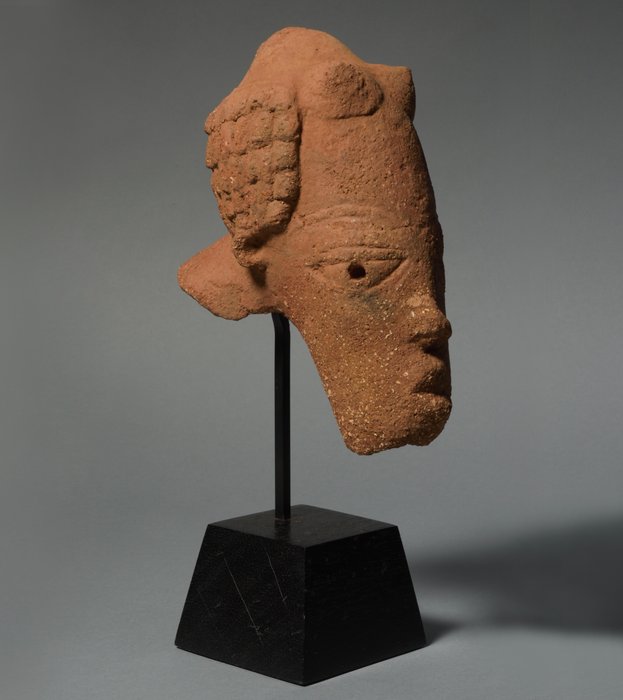 |
| Terracotta |
The remarkable civilization of the Nok was first discovered in 1928 when a wealth of unique terracotta artefacts was unearthed by tin miners in the southern part of Kaduna state in central Nigeria. Since then, extensive archaeological excavations and research into the Nok have revealed that they may have been the first complex civilization in West Africa, existing from at least 900 BC until their mysterious disappearance in around 200 AD.
The Nok were an extremely advanced society, with one of the most complex judicial systems of the time, and the earliest producers of life-sized terracotta in the Sub-Sahara. Archaeologists have also found stone tools, rock paintings and iron implements, including fearsome spear points, bracelets, and small knives.
Terracotta Statues

But by far the most enigmatic and intriguing aspect of the Nok Culture were their Terracotta statues, described by the mémoire d'afrique, which houses a gallery of the statues , as “extraordinary, astonishing, ageless, timeless and almost extraterrestrial”.
The figures, which date back to at least 500 BC, are almost always people with large, mostly elongated heads with almond-shaped hollow looking eyes are parted lips. These unusual features are particularly perplexing considering that the statues have been constructed accurately with relative proportions of the head, body and feet, leading some to use the term ‘extraterrestrial-looking’ when describing them.
Microscopic inspection of the clay used in the terracotta shows it to be remarkably uniform over the whole Nok area, suggesting that the clay came from a single, yet-undiscovered source. Not much is known about the purposes of these peculiar sculptures but some theories have suggested they were used as charms to prevent crop failure, illness and infertility, while others have suggested that they represent high status individuals who were worshipped by the people.
However, the construction of life-sized statues isn’t the only evidence of the advancement of their society. Research has revealed that the Nok people had a highly developed system of administration to ensure law and order.
Judicial System
It is a known fact that the Nok’s judicial system pre-dates the western judicial system. The Nok people created classes of courts used for adjudicating cases from minor civil cases, such as family disputes and false allegations, to criminal cases such as stealing, murder and adultery. The people believed that every crime attracts a curse which was capable of destroying whole family and therefore must be uncovered to avoid the consequences.The suspect was brought before an open court for traditional oath taking, which involved standing between two monoliths facing the sun, the most supreme god called Nom. The suspect then swore to tell the truth. Cases that cannot be resolved in the open court are taken to the high court which sits within an enclosed shrine.
The court was presided over by the Chief Priest and various clan heads. Anyone found guilty was fined goats and chicken for sacrifice to the gods and local wine for the chief priest. The town would then declare a day of celebration on which the people would thank the gods for their graces in successfully resolving the issue and averting doom for the people.
A Complex Society
It was not until the 21st century that sustained, systematic research was carried out on Nok culture, and the results have been stunning. The most recent finds, dated by thermo-luminescence testing and radio-carbon dating, indicate that Nok culture lasted from around 1200 B.C.E. to 400 C.E., yet we still do not know how it arose or what happened to it.
The sheer volume, as well as artistic and technical skills seen in the terracotta sculptures, suggests that Nok culture was a complex society. This is further supported by the existence of iron working (a demanding skill carried out by experts whose other needs like food and clothing must be met by others), and archaeological digs have shown that the Nok had sedentary farming. Some experts have argued that the uniformity of the terracotta - which suggests a single source of the clay - is evidence of a centralized state, but it could also be evidence of a complex guild structure. Guilds imply a hierarchical society, but not necessarily an organized state.
Disappearance
A sharp drop in the volume of pottery and terracotta in soil layers suggests that the once-thriving Nok population declined fairly rapidly and eventually evolved into the later Yoruba kingdom of Ife. The brass and terracotta sculptures of the Ife and Benin cultures show significant similarities with those found at Nokwatch Africa History The Nok Below:

By Binnabook Publishers
Historybook



Very good. but it is likely the Nok civilisation had branched to form the early Nupoid culture which Gwagbyi is among, before advancing to form the Yoruboid civilisation. The similarities of close affinity of Yoruba, Nupe and Gwagyi was discussed in the chronolinguistic approach of the protolanguage the were derived from.
ReplyDelete